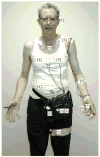Hyperventilation in panic disorder and asthma: empirical evidence and clinical strategies
- PMID: 20685222
- PMCID: PMC2937087
- DOI: 10.1016/j.ijpsycho.2010.05.006
Hyperventilation in panic disorder and asthma: empirical evidence and clinical strategies
Abstract
Sustained or spontaneous hyperventilation has been associated with a variety of physical symptoms and has been linked to a number of organic illnesses and mental disorders. Theories of panic disorder hold that hyperventilation either produces feared symptoms of hypocapnia or protects against feared suffocation symptoms of hypercapnia. Although the evidence for both theories is inconclusive, findings from observational, experimental, and therapeutic studies suggest an important role of low carbon dioxide (CO2) levels in this disorder. Similarly, hypocapnia and associated hyperpnia are linked to bronchoconstriction, symptom exacerbation, and lower quality of life in patients with asthma. Raising CO2 levels by means of therapeutic capnometry has proven beneficial effects in both disorders, and the reversing of hyperventilation has emerged as a potent mediator for reductions in panic symptom severity and treatment success.
2010 Elsevier B.V. All rights reserved.
Figures


Similar articles
-
The role of hyperventilation: hypocapnia in the pathomechanism of panic disorder.Braz J Psychiatry. 2007 Dec;29(4):375-9. doi: 10.1590/s1516-44462006005000048. Epub 2008 Jan 8. Braz J Psychiatry. 2007. PMID: 17713689 Review.
-
Respiratory biofeedback-assisted therapy in panic disorder.Behav Modif. 2001 Sep;25(4):584-605. doi: 10.1177/0145445501254006. Behav Modif. 2001. PMID: 11530717 Clinical Trial.
-
Voluntary hyperventilation in the treatment of panic disorder--functions of hyperventilation, their implications for breathing training, and recommendations for standardization.Clin Psychol Rev. 2005 May;25(3):285-306. doi: 10.1016/j.cpr.2005.01.002. Clin Psychol Rev. 2005. PMID: 15792851 Review.
-
Mediators of Change in Capnometry Guided Respiratory Intervention for Panic Disorder.Appl Psychophysiol Biofeedback. 2019 Jun;44(2):97-102. doi: 10.1007/s10484-018-9424-2. Appl Psychophysiol Biofeedback. 2019. PMID: 30539503
-
Hyperventilation symptoms are linked to a lower perceived health in asthma patients.Ann Behav Med. 2008 Feb;35(1):97-104. doi: 10.1007/s12160-007-9014-7. Epub 2008 Feb 16. Ann Behav Med. 2008. PMID: 18347909
Cited by
-
Panic and pandemic: Narrative review of the literature on the links and risks of panic disorder as a consequence of the SARS-CoV-2 pandemic.Encephale. 2021 Feb;47(1):38-42. doi: 10.1016/j.encep.2020.08.001. Epub 2020 Aug 10. Encephale. 2021. PMID: 33221039 Free PMC article. Review.
-
Nocturnal hypoxia in patients with sleep disorders: exploring its role as a mediator between neurotic personality traits and psychological symptoms.Front Psychiatry. 2024 Dec 6;15:1442826. doi: 10.3389/fpsyt.2024.1442826. eCollection 2024. Front Psychiatry. 2024. PMID: 39713765 Free PMC article.
-
Dysfunctional breathing phenotype in adults with asthma - incidence and risk factors.Clin Transl Allergy. 2012 Sep 19;2(1):18. doi: 10.1186/2045-7022-2-18. Clin Transl Allergy. 2012. PMID: 22992302 Free PMC article.
-
Dysfunctional breathing: a review of the literature and proposal for classification.Eur Respir Rev. 2016 Sep;25(141):287-94. doi: 10.1183/16000617.0088-2015. Eur Respir Rev. 2016. PMID: 27581828 Free PMC article. Review.
-
Functional respiratory complaints among COVID-19 survivors: a prospective cohort study.ERJ Open Res. 2023 May 2;9(3):00063-2023. doi: 10.1183/23120541.00063-2023. eCollection 2023 Jul. ERJ Open Res. 2023. PMID: 37131523 Free PMC article.
References
-
- Abelson JL, Nesse RM, Weg JG, Curtis GC. Respiratory psychophysiology and anxiety: cognitive intervention in the doxapram model of panic. Psychosomatic Medicine. 1996;58:302–313. - PubMed
-
- Abelson JL, Weg JG, Nesse RM, Curtis GC. Persistent respiratory irregularity in patients with panic disorder. Biological Psychiatry. 2001;49:588–595. - PubMed
-
- Abrams K, Rassovsky Y, Kushner MG. Evidence for respiratory and nonrespiratory subtypes in panic disorder. Depression and Anxiety. 2006;23:474–81. - PubMed
-
- Alpers HW, Wilhelm FH, Roth WT. Psychophysiological measures during exposure in driving phobics. Journal of Abnormal Psychology. 2005;114:126–139. - PubMed
Publication types
MeSH terms
Substances
Grants and funding
LinkOut - more resources
Full Text Sources
Medical

